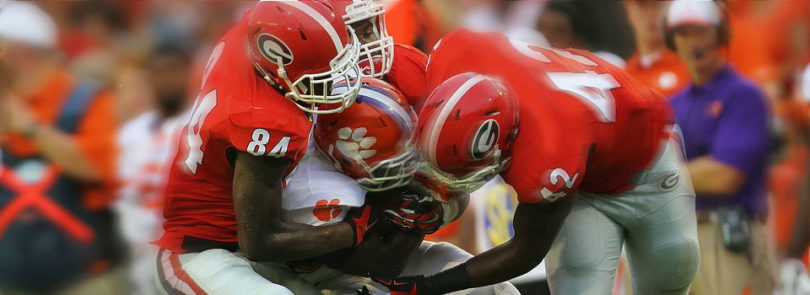University of Georgia researchers have been working to prevent concussion injuries to football players and to better understand the effects of those injuries, and the UGA concussion evaluation program is now part of the landmark $30 million NCAA-U.S. Department of Defense Grand Alliance, which is funding the most comprehensive study of concussion and head impact exposure ever conducted.
For its role in the alliance, UGA will receive $414,000 over three years. Julianne Schmidt, assistant professor of exercise science in the College of Education’s kinesiology department, said the project has three research arms, and UGA will be working on the Longitudinal Clinical Study Core, a prospective, multi-institution clinical research protocol whose aim will be to study the natural history of concussion among NCAA student-athletes. The University of Michigan is leading this part of the study; 11 other research universities and military academies are also participating.
The alliance was announced in May at the White House to enhance the safety of student-athletes and military service members. The study will enroll an estimated 25,000 male and female NCAA student-athletes over the three-year study period. Participants will receive a comprehensive preseason evaluation for concussion and will be monitored in the event of an injury. The investigation will be the largest ever of its type, offering critical insight to the risks, treatment and management of concussion.
UGA’s participation is an extension of its ongoing concussion research program. At the start of the 2013 season, Schmidt and the UGA Sports Medicine team wired 25 helmets with accelerometers, or sensors, that measure impact severity, hit location and frequency. Information from the sensors goes into athlete profiles that indicate who’s being hit and where contact is made on the helmet.
“No helmet will ever prevent a concussion because it will never tether the brain within the skull,” said Schmidt, who specializes in concussion research. But she and senior associate athletic director for sports medicine Ron Courson, who is working with her on the research, hope to make the game safer.
Schmidt said the first year of the study did not capture enough data on head impacts that resulted in concussions to make any clear recommendations, but the results provided enough information for coaches to talk to players about dangerous habits.
“We had one lineman with significantly more impacts than the others,” Courson said. “We could see from the data he was leading with his head rather than his hands.”
Schmidt said they did get enough data about non-concussive impacts to expand their research. “Using that data, we can identify players who are sustaining a lot of high-magnitude head impacts or a lot of impacts to certain locations,” Schmidt said. “Down the road, we hope to track players to determine whether their exposure to head impacts plays a role in their brain function later in life.”
One of her graduate students published an abstract that compared the scout team players to the varsity players and found that scout team players get hit less often, but when they do get hit, it’s higher in magnitude.
Also, an undergraduate research assistant submitted an abstract to the Center for Undergraduate Research Opportunities that looked at facemask weight and head impacts. She found that players with heavier facemasks tended to lower their head and sustain head impacts to the top of their head more often, which is considered to be a dangerous head impact location. Schmidt said the study supports recent efforts to ban elaborate facemasks with a lot of bars and weight to them because they change the dynamics of the helmet and the way a player plays the sport in a more dangerous way.
Schmidt said they are currently studying the readiness of individuals to return to driving following a concussion and monitoring physical activity and sleep of those who have suffered a concussion.
***
Preventing a concussion is harder than it might sound. The brain sits inside the skull, suspended in cerebral fluid. When the head stops and the brain keeps moving, it can hit the skull, causing trauma on the surface of the brain as well as in the center where it is tethered by the spinal cord.
Football accounts for 37 percent of concussions, according to an NCAA national annual estimate of concussions for practice and competition in 14 NCAA sports (data from 2004-09). The next largest percentage was women’s soccer at 12 percent. Last year, UGA reported 10 concussions among football team players, although two were from accidents that occurred outside of practice and games.
“We are hoping imaging techniques improve and maybe with biomarkers we could have some way of detecting it,” said Schmidt, who also serves as director of UGA’s Concussion Research Laboratory in the athletics department. “But I think we are always going to rely on people reporting them.”
In addition to identifying the kinds of impacts that result in concussions and exploring the effects of non-concussive impacts on short- and long-term health, Schmidt works on refining the evaluation process for concussions.
“Right now, we have a set of tools that most clinicians use, and we think they are good. But there is a growing body of research that suggests there may be more going on, so we want to look at that a little further,” she said.
At UGA, the medical team uses a dynamic balance measure; a vision test that shows visual reaction time; and a neuropsychological test that measures memory, reaction time and cognition against an already-established baseline.
“An athlete complaining of headache, dizziness and confusion could be [showing] symptoms of a concussion. It could also be heat exertion-they have the exact same signs and symptoms,” Courson said. “Not every headache is a concussion.”
If a diagnosis is in question, the team follows this mantra: “When in doubt, sit them out.”
Most concussions heal within seven to 10 days, but student-athletes face an additional challenge. If they go to class, their symptoms often get worse.
“It’s like running on an injured knee. It would hurt if you ran on it, which is an indicator that you put too high a load on that knee,” Schmidt says. “It is the same thing if you go into a classroom with a concussion. You have to remember things to study for an exam, and it may put too much load on the brain that is trying to repair itself.”
When it comes to concussions, the best medicine may be prevention-which Courson and Schmidt will continue to explore.
“[Football] is a collision sport, a violent game,” Courson said, “but I think we can make significant strides in preventing concussions.”







